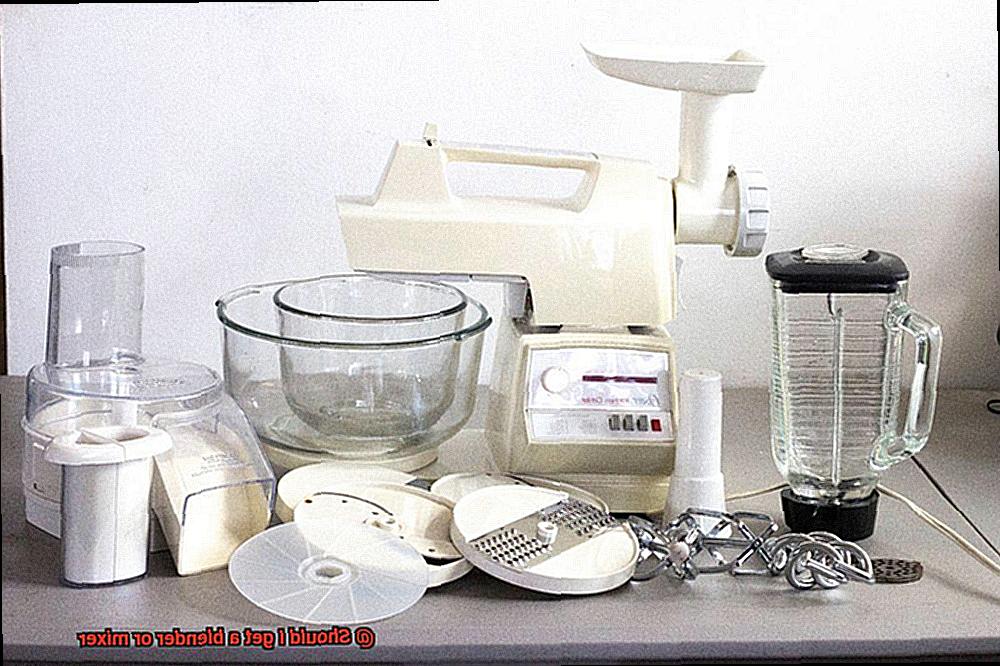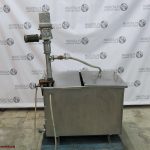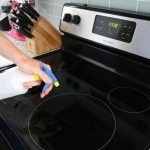Are you stuck in a dilemma about whether to buy a blender or mixer? Kitchen gadgets have become all the rage lately, and with so many options available, it can be overwhelming to decide which one suits your needs. Whether you’re an experienced cook, a beginner chef, or simply a smoothie enthusiast, choosing between a blender or mixer can be a daunting task.
Each appliance has its own unique set of features and benefits that serve different purposes in the kitchen. A blender is perfect for liquefying ingredients and creating velvety smoothies, soups, and purees. On the other hand, a mixer is great at whipping cream, creaming butter and sugar together, and kneading dough – making it ideal for baking and pastry recipes.
But how do you know which one is right for you? Are you looking for an appliance to make protein shakes or blend up purees for your little one’s food? Do you want to make bread from scratch or whisk up a fluffy cake batter? The answers to these questions will help steer you in the right direction.
In this blog post, we’ll guide you through the pros and cons of owning a blender or mixer so that you can make an informed decision. We’ll discuss what each appliance is best used for, what to look out for when purchasing one, as well as the features that matter most. So sit tight and let’s dive into whether you should get yourself a blender or mixer for your kitchen.
Contents
Advantages of a Blender
As someone who knows their way around a kitchen, I can confidently say that blenders are an indispensable tool for anyone who wants to prepare scrumptious drinks or meals. Blenders possess a myriad of advantages over mixers, particularly when it comes to making smoothies, purees, sauces, and soups.
One of the primary advantages of a blender is its ability to transform ingredients into a smooth and consistent texture. With razor-sharp blades that rotate at high speeds, blenders can effortlessly chop and mix ingredients into a fine paste or liquid. This makes it the perfect appliance for preparing smoothies, milkshakes, and purees that require uniformity.
Blenders are also ideal for making soups and sauces. Simply add cooked vegetables or fruits into the blender, blend them into a smooth puree, and then pour the mixture back into the pot to heat up. This method saves time and effort compared to using a mixer or food processor.
Ease of use is another advantage that blenders offer. With uncomplicated controls that allow you to adjust the speed and blending time according to your preference, blenders are easy to operate. Most models also feature removable blades and jars that are dishwasher safe, ensuring that clean-up is quick and hassle-free.
Blenders are also perfect for crushing ice and frozen fruits. If you enjoy making frozen cocktails or smoothies with ice, then a blender is an essential appliance in your kitchen. The powerful motor and razor-sharp blades can crush ice cubes into small pieces within seconds, giving you a perfect consistency every time.
Advantages of a Mixer
Look no further than a mixer. As a culinary expert, I can attest to the many advantages of using a mixer in your kitchen.
First and foremost, mixers offer unparalleled versatility. With various attachments available, you can perform multiple tasks with just one appliance. From kneading dough for homemade bread to whipping cream for that perfect dessert topping, a mixer has got you covered.
But the advantages don’t stop there. Mixers also offer hands-free operation, which means you can set it and forget it while you focus on other tasks in the kitchen. This feature is especially useful when you have a lot of ingredients to mix or need to keep an eye on other dishes while your mixer does its job.
And let’s talk about consistency – an essential aspect of any recipe. While blenders are great for making smoothies and purees, mixers offer better consistency for tasks like thoroughly mixing ingredients together. This leads to a more consistent texture and flavor in your finished product.
But wait, there’s more. Mixers also save time by completing tasks quickly and efficiently. They’re especially useful when preparing large batches of baked goods or mixing tough ingredients like bread dough. Plus, with precise measurements and control over the mixing process, you can ensure that your recipe turns out perfectly every time.
To summarize, here are the top advantages of a mixer:
- Versatility: multiple attachments allow for various cooking and baking tasks
- Hands-free operation: frees up your hands to focus on other tasks
- Consistency: thorough mixing ensures a consistent texture and flavor
- Time-saving: completes tasks quickly and efficiently
- Precision: precise measurements and control over the mixing process ensures perfect results every time
The Best Uses for Each Appliance
A blender and a mixer are must-haves for any home cook. But what are the best uses for each appliance?
Let’s start with blenders. Blenders are ideal for creating smooth and consistent textures in liquid-based dishes such as smoothies, soups, and purees. Whether you need to whip up a quick breakfast smoothie or make a creamy tomato soup, a blender is the perfect tool for achieving that velvety texture you crave. With multiple speed settings and pulse options, blenders offer versatility in the kitchen and can even tackle tougher ingredients like nuts.
Now let’s move on to mixers. If baking is more your thing, then a mixer is a must-have appliance. Mixers are designed to knead doughs and mix ingredients for baked goods such as bread, cakes, and cookies. With attachments such as whisks, dough hooks, and beaters, mixers offer flexibility in preparing different types of dough and making different kinds of batter. Some models even have bowl-lift mechanisms and tilt-head designs for easy access.
Blenders and mixers aren’t just limited to these standard uses. Here are some other creative ways to use them:
- Blenders can be used to make homemade nut milk or grind coffee beans.
- Mixers can be used to shred cooked chicken or mix up homemade whipped cream.
Considerations When Choosing Between Blenders and Mixers
When it comes to kitchen appliances, blenders and mixers are two of the most popular and versatile tools. However, each appliance has its own unique features and functions that make them better suited for certain tasks. So, how do you choose between a blender and a mixer? As an expert in this field, here are some key considerations to keep in mind.
Firstly, think about what you plan on using the appliance for. Do you want to create silky smooth smoothies, soups, and purees? If so, then a blender should be your top pick. But if you’re someone who loves to bake and cook from scratch, then a mixer may be more your speed. Choosing the right appliance that caters to your specific needs is key.
The blades or attachments that come with each appliance are also important factors to consider. Blenders typically have sharp blades that can break down foods into a smooth consistency, while mixers often come with various attachments such as whisks or dough hooks. If you’re looking for versatility and an appliance that can handle multiple tasks, then a mixer with various attachments may be the way to go.
Size and capacity are also crucial considerations when choosing between a blender and mixer. Blenders tend to have larger capacities than mixers, which makes them ideal for creating large batches of smoothies or soups. However, mixers often have larger bowls which can be helpful when mixing large amounts of dough or batter. So depending on your needs, you may want to consider which appliance is better suited for the size of your kitchen and cooking requirements.
Last but not least, let’s talk budget. Both blenders and mixers can be expensive depending on the brand and model. However, blenders tend to be less expensive than mixers. That being said, if you plan on using your appliance frequently and for heavy-duty tasks, investing in a high-quality mixer may be worth the cost in the long run.
Factors to Take Into Account When Buying a Blender or Mixer
Firstly, consider the types of foods or drinks you plan on making. If smoothies, purees, and soups are on your list, then a blender is the perfect choice. On the other hand, if whipping cream, mixing dough, or beating eggs is what you have in mind, then a mixer may be more suitable.
Size and capacity are also important considerations. If you’re planning on creating large batches of food or drink, then a blender may be the better option as they come in larger sizes and can handle larger quantities of ingredients. However, if you have limited kitchen space or only plan on making smaller batches, then a mixer may be a better fit.
Ease of use is another vital factor to keep in mind. Blenders are generally simple to use and require less effort to operate than mixers. Additionally, they come with a wider range of settings and functions that allow you to customize your blending experience to suit your needs.
Durability and quality are essential factors when purchasing an appliance that will last longer and perform better. Opt for a blender or mixer made from high-quality materials such as stainless steel or heavy-duty plastic rather than cheaper alternatives.
Last but not least, price is always an important consideration. While blenders tend to be more expensive than mixers, they offer more versatility and functionality. It’s crucial to weigh the cost against the benefits when making your decision.
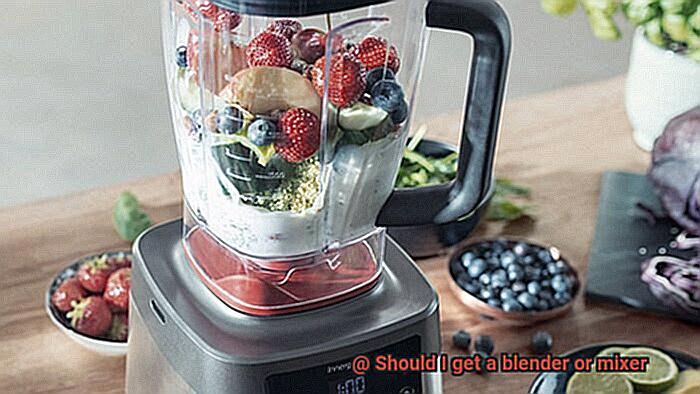
Popular Brands and Models of Blenders and Mixers
Look no further than the wide array of popular brands and models of blenders and mixers available on the market today. As an expert on these essential kitchen appliances, let’s explore some of the best options out there to suit your unique needs and preferences.
First up, we have Vitamix – a brand known for its high-quality blenders that can blend anything from smoothies to soups. The Vitamix 5200 is a top-rated blender with a powerful motor and variable speed control, making it perfect for tackling even the toughest ingredients like nuts and seeds. Its durable construction ensures it will be a staple in your kitchen for years to come.
If you’re looking for a blender that makes blending faster and easier, Blendtec is the brand for you. The Blendtec Designer Series is a popular model with six pre-programmed blend cycles, allowing you to create anything from smoothies to ice cream with ease. Plus, its sleek design will add a touch of style to your countertop.
Now, let’s talk mixers. KitchenAid is a household name in this category, offering a range of models to suit different needs. The KitchenAid Artisan Series Stand Mixer is a fan favorite – versatile, durable, and powerful. With ten-speed settings and various attachments available, this mixer can tackle everything from whipping cream to mixing dough.
Cuisinart is another well-known brand in the mixer category. The Cuisinart SM-50BC Stand Mixer is a top-rated model with twelve-speed settings and various attachments included. From cake batter to bread dough, this mixer can handle it all while looking sleek on your countertop.
Tips for Using Blenders and Mixers Safely
Blenders and mixers are powerful appliances that can be incredibly useful in the kitchen. However, it’s important to take safety precautions to avoid any accidents or injuries. Here are some tips to keep in mind:
- Read the manual thoroughly before using the appliance. The manual will provide important information on how to use the appliance safely and any potential hazards to watch out for.
- Keep your hands and utensils clear of the blades while the blender or mixer is in use. The blades are sharp and can cause serious injury if you try to reach inside while the appliance is still running.
- Be cautious when using blenders and mixers around children. Children may be curious about these appliances, but they can be dangerous if not used properly. Make sure to keep them out of reach of children and never leave them unattended while in use.
- Don’t overload the appliance with too much food or liquid. Overloading can cause the appliance to overheat or break down. Follow the manufacturer’s instructions on how much food or liquid to add at one time.
- Keep the appliance clean and dry to avoid the buildup of harmful substances such as bacteria. Always unplug the appliance before cleaning, and never submerge the motor in water.
Additionally, it’s important to keep cords away from water sources when using a blender or mixer near a sink to prevent electrocution.
Maintenance Tips for Keeping Your Appliances in Good Working Order
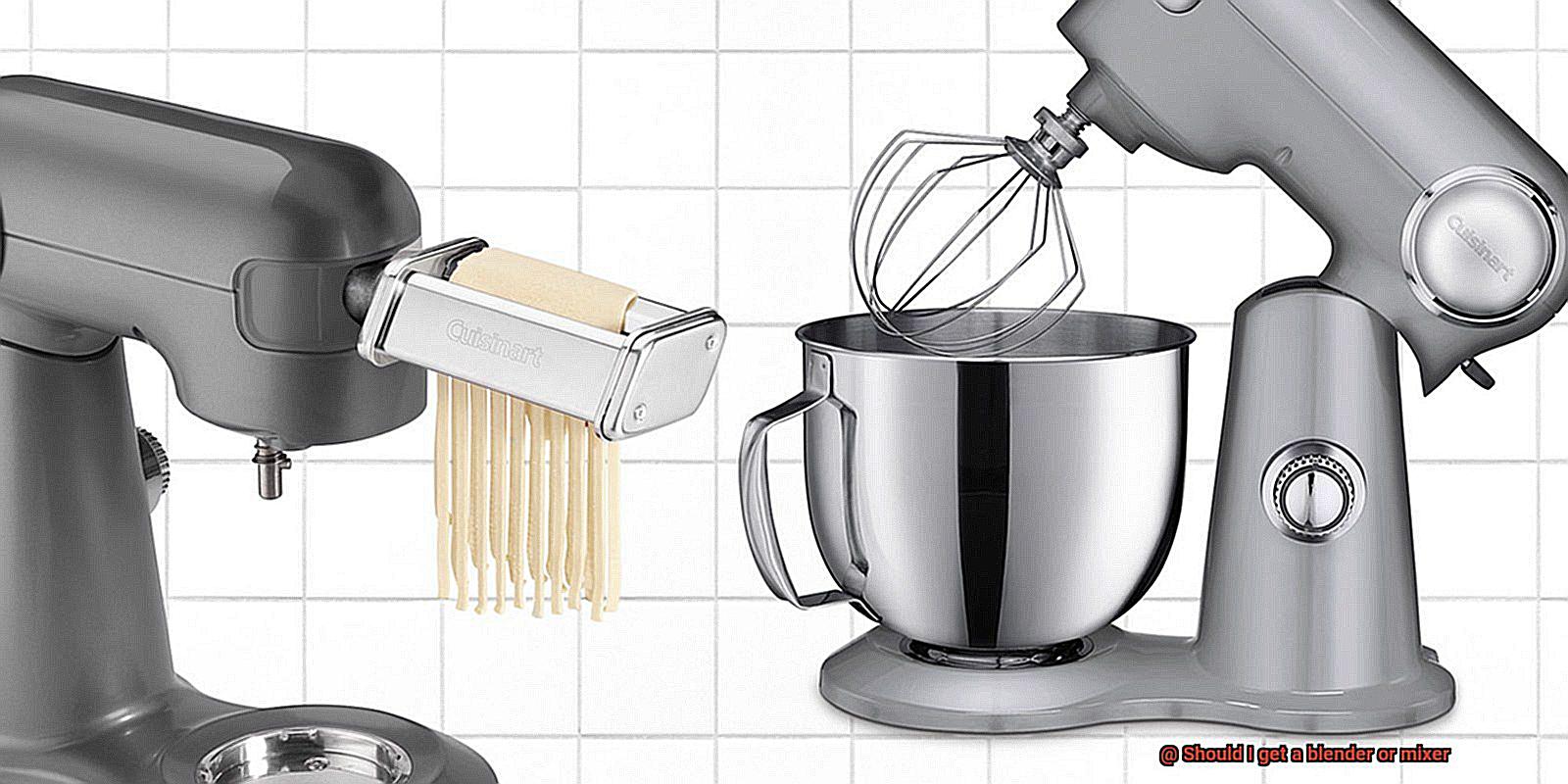
If you want your blender or mixer to last for years, it’s essential to take care of them properly. Here are some maintenance tips to help you ensure that your appliances continue to work at their best.
Clean Your Blender or Mixer After Every Use
Cleaning your blender or mixer after every use is the most important tip to keep in mind. It prevents any leftover residue or buildup from affecting the next use. Make sure to unplug the appliance before cleaning and wipe down the exterior with a damp cloth. For blenders, disassemble the blades and wash them separately. For mixers, use a toothbrush to clean the beaters and attachments. This will ensure that your appliance stays hygienic and free from any unpleasant odors.
Check for Signs of Wear and Tear
Another important maintenance tip is to check for any signs of wear and tear on your appliance. If you notice any cracks or breaks in the plastic or rubber parts, it may be time to replace them. This will prevent any accidents or injuries while using the appliance and ensure that it continues to function safely.
Store Your Blender or Mixer Properly
Proper storage is essential for keeping your blender or mixer in good working order. Keep them in a dry place away from moisture and humidity. Avoid storing them near heat sources or in direct sunlight, as this can cause damage to the motor. By storing your appliance correctly, you can prevent any unnecessary wear and tear caused by environmental factors.
Follow Manufacturer’s Instructions
It’s crucial to follow the manufacturer’s instructions for your blender or mixer. This includes using the appropriate attachments, not overloading the appliance, and using it for its intended purpose only. By following these guidelines, you can avoid any damage caused by improper use and ensure that your appliance lasts for a long time.
Regular Maintenance
Regular maintenance is key to keeping your blender or mixer running smoothly and preventing breakdowns. In addition to cleaning, it’s important to lubricate the motor and check the seals on the lid and blade assembly. By keeping up with regular maintenance, you can extend the lifespan of your appliance and save money in the long run.
PheGoR-3bKA” >
Conclusion
In summary, deciding between a blender or mixer can be overwhelming, but it ultimately depends on your individual needs and preferences. Blenders excel at creating smooth and consistent textures in liquid-based recipes such as soups, smoothies, and purees. They also handle crushing ice and frozen fruits with ease. Meanwhile, mixers offer unparalleled versatility with attachments for various cooking and baking tasks like kneading dough, whipping cream, and mixing ingredients together.
When shopping for an appliance, consider factors such as intended use, blade or attachment options, size and capacity, ease of use, durability and quality, and cost. Popular brands like Vitamix and Blendtec are known for high-quality blenders while KitchenAid and Cuisinart offer top-rated mixers.
It’s critical to prioritize safety when using these powerful appliances by thoroughly reading the manual before use, keeping hands clear of blades while in operation, being mindful around children, avoiding overloading the appliance with too much food or liquid, and keeping cords away from water sources to prevent electrocution.
Lastly, regular maintenance is key to extending the lifespan of your blender or mixer. Clean after every use, inspect for signs of wear regularly store properly away from moisture or heat sources. Follow manufacturer’s instructions for proper use only.

